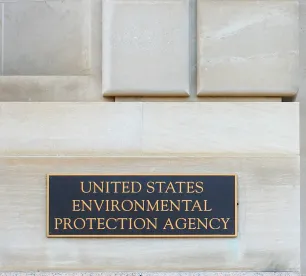EPA’s Assistant Administrator for the Office of Enforcement and Compliance Assurance (OECA) Susan Bodine recently issued a new policy document titled “Enhancing Effective Partnerships Between the EPA and the States in Civil Enforcement and Compliance Assurance Work.” With this policy, EPA gives form to its cooperative federalism goals, deferring primary environmental enforcement to states.
Directed to Regional EPA Administrators, the policy sets forth “expectations and procedures” designed to enhance “effective partnerships in civil enforcement and compliance assurance” between EPA and states that implement federal programs under statutes such as the Clean Air Act and Clean Water Act and builds on prior guidance, including EPA Administrator Wheeler’s October 30, 2018 memorandum regarding the role of states in enforcing federal environmental laws. The new policy:
-
Prioritizes joint planning and communication between EPA and states.
-
Outlines the roles of EPA and the states.
-
Describes “best practices” for elevating and resolving areas of disagreement between EPA and the states.
Periodic Joint Work Planning
The policy emphasizes the importance of joint planning and communication between EPA and the States, espousing a “no surprises” principle as foundational. The policy clearly explains that the overall goal of joint planning is to share its enforcement responsibilities with states. In order to achieve that goal, the policy states that joint planning should include strategic planning, joint inspection planning, and joint enforcement planning. EPA aims to “avoid duplicate efforts, improve efficiency, and reduce unnecessary burdens on the regulated community. “ This means that regulated businesses are increasingly likely to interface with either their state regulator or EPA, but are less likely to deal with both on facility inspections, follow-up information requests, and enforcement actions.
Roles of the EPA and States in Implementing Authorized Programs
The policy also reinforces EPA’s position that it will generally defer to states as the primary enforcers of federal environmental laws. However, EPA identifies a number of circumstances in which the agency may exercise its concurrent jurisdiction. Many of these circumstances where EPA will take direct action are unsurprising and include, for example:
-
When a state requests EPA take the lead.
-
When there is an emergency.
-
When criminal enforcement is required (as most states lack criminal environmental programs).
-
When violations involve multi-state or multi-jurisdictional interests or impacts.
Significantly, EPA says it will also take direct enforcement action for violations under National Compliance Initiatives when the state lacks the resources, expertise, or equipment to enforce violations, or when “significant” violations have not been “timely or appropriate addressed” by the state. Notably, however, the policy does not explain which factors EPA will use to evaluate timeliness or appropriateness of a state’s action.
Process for the Elevation of Issues
Finally, EPA sets out “best practices” for EPA and state agency employees to resolve conflicts, starting at the lowest level and escalating up through EPA Regional Administrators and State Secretaries or Commissioners, with EPA’s Assistant Administrator for OECA issuing a “final decision” where necessary. The policy also provides time periods in which these steps should occur.
Conclusion
As EPA’s “Effective Partnerships” memo is implemented, regulated companies can expect to deal increasingly with state environmental agency civil compliance and enforcement programs, and less frequently with EPA. Industries that fall under the National Compliance Initiatives should not see a decreased EPA role as the agency maintains primacy in these areas to ensure national consistency for its highest priorities. Whether a company ultimately deals with state or federal environmental inspectors, a strong internal compliance program remains the best “ounce of prevention.”





 />i
/>i

